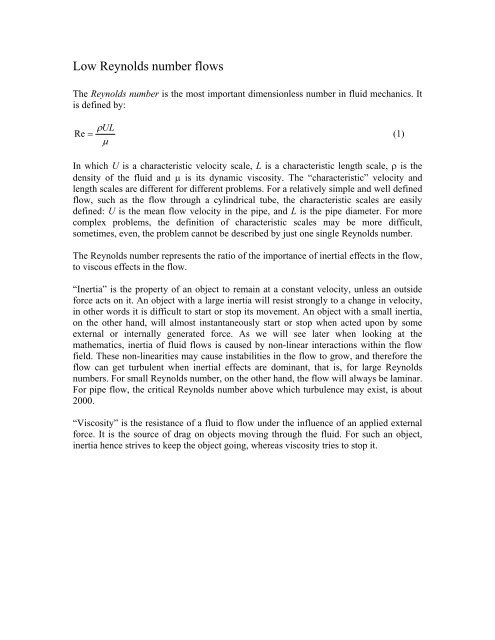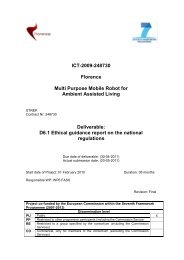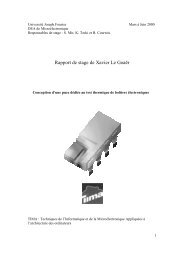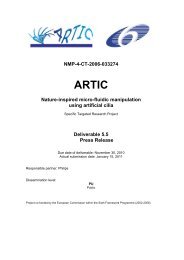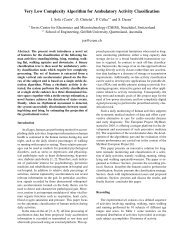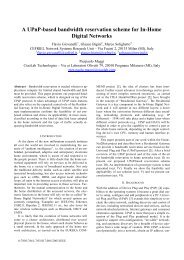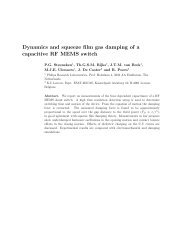Low Reynolds number flows.pdf - Hitech Projects
Low Reynolds number flows.pdf - Hitech Projects
Low Reynolds number flows.pdf - Hitech Projects
Create successful ePaper yourself
Turn your PDF publications into a flip-book with our unique Google optimized e-Paper software.
<strong>Low</strong> <strong>Reynolds</strong> <strong>number</strong> <strong>flows</strong><br />
The <strong>Reynolds</strong> <strong>number</strong> is the most important dimensionless <strong>number</strong> in fluid mechanics. It<br />
is defined by:<br />
ρUL<br />
Re =<br />
(1)<br />
µ<br />
In which U is a characteristic velocity scale, L is a characteristic length scale, ρ is the<br />
density of the fluid and µ is its dynamic viscosity. The “characteristic” velocity and<br />
length scales are different for different problems. For a relatively simple and well defined<br />
flow, such as the flow through a cylindrical tube, the characteristic scales are easily<br />
defined: U is the mean flow velocity in the pipe, and L is the pipe diameter. For more<br />
complex problems, the definition of characteristic scales may be more difficult,<br />
sometimes, even, the problem cannot be described by just one single <strong>Reynolds</strong> <strong>number</strong>.<br />
The <strong>Reynolds</strong> <strong>number</strong> represents the ratio of the importance of inertial effects in the flow,<br />
to viscous effects in the flow.<br />
“Inertia” is the property of an object to remain at a constant velocity, unless an outside<br />
force acts on it. An object with a large inertia will resist strongly to a change in velocity,<br />
in other words it is difficult to start or stop its movement. An object with a small inertia,<br />
on the other hand, will almost instantaneously start or stop when acted upon by some<br />
external or internally generated force. As we will see later when looking at the<br />
mathematics, inertia of fluid <strong>flows</strong> is caused by non-linear interactions within the flow<br />
field. These non-linearities may cause instabilities in the flow to grow, and therefore the<br />
flow can get turbulent when inertial effects are dominant, that is, for large <strong>Reynolds</strong><br />
<strong>number</strong>s. For small <strong>Reynolds</strong> <strong>number</strong>, on the other hand, the flow will always be laminar.<br />
For pipe flow, the critical <strong>Reynolds</strong> <strong>number</strong> above which turbulence may exist, is about<br />
2000.<br />
“Viscosity” is the resistance of a fluid to flow under the influence of an applied external<br />
force. It is the source of drag on objects moving through the fluid. For such an object,<br />
inertia hence strives to keep the object going, whereas viscosity tries to stop it.
Table 1: A spectrum of <strong>Reynolds</strong> <strong>number</strong>s for self-propelled organisms (after Vogel 1 ).<br />
<strong>Reynolds</strong> <strong>number</strong><br />
A large whale swimming at 10 m/s 300,000,000<br />
A tuna swimming at the same speed 30,000,000<br />
A duck flying at 20 m/s 300,000<br />
A large dragon fly going 7 m/s 30,000<br />
A copepod in a speed burst of 0.2 m/s 300<br />
Flapping wings of the smallest flying insects 30<br />
An invertebrate larva, 0.3 mm long, at 1 mm/s 0.3<br />
A sea urchin sperm advancing the species at 0.2 mm/s 0.03<br />
A bacterium, swimming at 0.01 mm/s 0.00001<br />
Let us look at some characteristic <strong>Reynolds</strong> <strong>number</strong>s for self propelled organisms from<br />
nature, shown in Table 1. The characteristic length scale is the size of the organism, the<br />
characteristic velocity is its swimming speed. The density and viscosity are those of<br />
water, i.e. ρ=1000 kg/m 3 and µ=1 mPa s or air, i.e. ρ=1.2 kg/m 3 and µ=0.018 mPa s. We<br />
can see that the <strong>Reynolds</strong> <strong>number</strong>s range from very large values, for a swimming whale,<br />
to extremely small values for swimming bacteria. That means that for a whale, inertial<br />
effects dominate, and thus, after stopping to swim, the whale will continue to move<br />
further, or “coast” for a substantial distance and time. For a bacterium, on the other hand,<br />
inertial effects will not be important at all and viscous effects dominate, so that a<br />
bacterium will stop almost instantaneously.<br />
Now, the mathematics! Fluid flow is described by the Navier-Stokes equation, that<br />
describes the evolution of the velocity vector field:<br />
∂u<br />
r r 1 µ 2 r<br />
+ ( u ⋅∇)<br />
u = − ∇p<br />
+ ∇ u<br />
∂t<br />
ρ ρ<br />
In this equation, u r is the velocity vector and p is the pressure. On the left-hand side, the<br />
first term is the unsteady (time-dependent) inertial component (in fact, it is the<br />
acceleration of the flow). The second term is the non-linear inertial term. On the righthand<br />
side, the first term is the driving pressure gradient, and the final term represents<br />
viscous dissipation.<br />
We are going to estimate the relative importance of the various terms in the Navier-<br />
Stokes equation by scaling the terms using a characteristic velocity U and a characteristic<br />
length L. Hence:<br />
The velocity u r scales with U,<br />
The spatial derivative ∇ scales with 1/L,<br />
Time t scales with L/U (this is called the “advective” time scale).<br />
1 S. Vogel, Life in moving fluids, Princeton University Press, 1994.<br />
(2)
This scaling implies the following for the various terms:<br />
Unsteady inertia scales with U 2 ∂u /L, i.e.<br />
∂t<br />
r<br />
is of the order O ⎟ ⎛U<br />
⎞<br />
⎜<br />
⎝ L ⎠<br />
2<br />
,<br />
Non-linear inertia scales also with U 2 r r<br />
/L, i.e. ( u ⋅ ∇)u<br />
is of the order O ⎟ ⎛U<br />
⎞<br />
⎜<br />
⎝ L ⎠<br />
2<br />
,<br />
The viscous term scales with µU/ρL 2 , i.e. u r µ 2<br />
⎛ µ U ⎞<br />
∇ is of the order O⎜ ⎟ . 2<br />
ρ<br />
⎝ ρL<br />
⎠<br />
From this scaling, it follows that the ratio of the inertia terms to the viscous term scales<br />
as:<br />
ρUL<br />
Ratio of inertial terms to viscous term: = Re<br />
µ<br />
which is the previously defined <strong>Reynolds</strong> <strong>number</strong>. If the <strong>Reynolds</strong> <strong>number</strong> is very small,<br />
i.e. much smaller than one, Re
atio between the inertial terms and the viscous terms, therefore, scales as ρL 2 /µT. This can be interpreted<br />
as the <strong>Reynolds</strong> <strong>number</strong> for periodic <strong>flows</strong>, ReT. The <strong>number</strong> is also known, however, as the Stokes<br />
<strong>number</strong>, St. Again, if St, or ReT is very small, i.e. much smaller than one, the inertial effects in the<br />
periodically driven flow can be neglected in the Navier-Stokes equation, and the Stokes equation (3) is<br />
obtained again. The balance between the viscous stresses and the pressure gradient, now imply that the<br />
⎛ µ ⎞<br />
pressure must scale as p=O⎜ ⎟ .<br />
⎝ T ⎠<br />
Figure 1: Patterns in fluid flow around a cylinder as a function of the <strong>Reynolds</strong> <strong>number</strong>.<br />
It is now, hopefully, clear, that the nature of a fluid flow can be completely different<br />
depending on the <strong>Reynolds</strong> <strong>number</strong>. This can be illustrated with some practical examples.<br />
Figure 1, for example, shows the flow patterns that are caused by the flow around a<br />
ρUR<br />
cylinder. The <strong>Reynolds</strong> <strong>number</strong>, in this case, is defined as Re = , where U is the<br />
µ<br />
flow velocity, R is the radius of the cylinder, and ρ and µ are the fluid properties. For<br />
small <strong>Reynolds</strong> <strong>number</strong>s, when inertia is not important, the flow is smooth and laminar.<br />
For higher <strong>Reynolds</strong> <strong>number</strong>s, inertia begins to play a role and two stationary vortices are<br />
present behind the cylinder. At still higher Re, where inertia is dominant, vortex shedding<br />
starts, i.e. the vortices are not stationary anymore but detach from the top and bottom of<br />
the cylinder. This happens in an alternating fashion and this flow pattern is known as the<br />
Von Karman vortex street. At this stage, the flow is still not turbulent: although the flow<br />
shows vortices, they are laminar there is no chaotic motion if the fluid. At the highest<br />
<strong>Reynolds</strong> <strong>number</strong>s, turbulence sets in and the wake behind the cylinder is filled with<br />
chaotic fluid motion.
Figure 2: A fish swimming, generating eddies with its moving tail, and the vortices behind flying<br />
birds (hovering, flying slowly forward, and flying rapidly forward). 2<br />
Figure 2 shows the flow patterns due to a swimming fish and flying birds. As we have<br />
seen already in Table 1, these flow are characterized by relatively large <strong>Reynolds</strong><br />
<strong>number</strong>s. This is evidenced by the existence of vortices, that shed from the tail or the<br />
wings of the animals, and the formation of which is essential for the propulsion.<br />
Table 2 summarizes the general differences between low (1) <strong>Reynolds</strong><br />
<strong>number</strong> <strong>flows</strong>.<br />
Table 2: Characteristics of low- and high-<strong>Reynolds</strong> <strong>number</strong> <strong>flows</strong>.<br />
High <strong>Reynolds</strong> <strong>number</strong> flow >>1) <strong>Low</strong> <strong>Reynolds</strong> <strong>number</strong> flow ( Re
Figure 3: A hypothetical swimmer, having a spherical main body and two arms that it can use to<br />
propel itself.<br />
In Figure 4, our swimmer moves its arms back and forth in a symmetric way. That is, the<br />
shape of the arms is the same during the forward stroke as during the backward stroke. If<br />
the duration of the forward stroke equals that of the backward stroke, the swimmer will<br />
not swim far: irrespective of the value of the <strong>Reynolds</strong> <strong>number</strong>, it will just oscillate<br />
around the same fixed position. Hence, the reciprocal movement of the arms does not<br />
result in a net swimming speed. Now what if forward stroke is much faster than the<br />
backward stroke? The force applied during the forward stroke will be larger than during<br />
the backward stroke. Will the swimmer actually swim?<br />
The answer depends on the <strong>Reynolds</strong> <strong>number</strong> regime, in other words, whether inertia or<br />
viscous effects dominate the flow. First, it is important to realize that, for the effectives of<br />
a stroke of the arms, not the applied force F is important, but the impulse, which is equal<br />
to:<br />
I =<br />
T<br />
∫<br />
0<br />
Fdt<br />
and T is the duration of the stroke.<br />
If the organism in Figure 4 is large, or of the stroke velocity is very fast, then the<br />
<strong>Reynolds</strong> <strong>number</strong> is high and inertia plays a determining role. In that case, the force the<br />
r r<br />
arm applies on the fluid is dominated by inertia (the term ( u ⋅ ∇)u<br />
in the Navier-Stokes<br />
equation (2)), which scales with the square of the stroke velocity V, hence F∼V 2 . In that<br />
case, the impulse scales as:<br />
I ≈ V T ≈ V<br />
2<br />
(large Re) (5)<br />
The last step follows from the fact that the stroke velocity V scales with the reciprocal<br />
stroke duration, 1/T. From equation (5) we see that, if the stroke velocity is larger, then<br />
the impulse is larger. That means that moving the arms fast in one direction, but slowly in<br />
the other indeed helps to swim, even though the shape of the movement is not<br />
asymmetric. If we suppose that our swimmer of Figure 4 has a fast forward stroke, and a<br />
(4)
slow backward stroke, then it will travel a net distance to the right, since the impulse<br />
applied during the forward stroke is larger than that during the backward stroke. A net<br />
“thrust” is produced.<br />
forward stroke<br />
backward stroke<br />
Figure 4: Our hypothetical swimmer moves its arms in a symmetric way: the shape during the<br />
forward stroke is the same as during the backward stroke. Depending on the <strong>Reynolds</strong> <strong>number</strong><br />
regime, the swimmer will indeed swim, or just oscillate around the same position and travel no net<br />
distance.<br />
At low <strong>Reynolds</strong> <strong>number</strong>s, which we would have for very small swimmers, the situation<br />
becomes different. Now, inertia does not play a role anymore and viscous forces are<br />
dominant. That means that the force applied by the arms is determined by the viscous<br />
term in the Navier-Stokes equation, i.e. u r µ 2<br />
∇ , which scales linearly with velocity, that<br />
ρ<br />
is F∼V. The impulse then scales as:<br />
I ≈ VT ≈ constant (small Re) (6)<br />
Thus the impulse is independent of the stroke velocity! That means that it does not matter<br />
how fast the arms are moving, the impulse applied during one stroke is unaffected (so<br />
long as Re
forward stroke<br />
backward stroke<br />
Figure 5: This hypothetical swimmer moves its arms in an asymmetric way: during the forward<br />
stroke they are more extended, and the effect on the surrounding fluid is maximized, whereas during<br />
the backward stroke the arms are more bent, minimizing the effect on the fluid. The swimmer will<br />
move to the right.<br />
To produce net flow, or thrust, in low <strong>Reynolds</strong> <strong>number</strong> situations, there must be an<br />
asymmetry in shape. An asymmetry in time, as we have just seen, is not sufficient. The<br />
swimmer in Figure 5 moves its arms asymmetrically. During the forward stroke, its arms<br />
are extended, maximizing the effect on the surrounding fluid. During the backward<br />
stroke, the arms are folded, minimizing their influence on the fluid. This difference in<br />
shape form the two directions of movement results in a difference in drag force, and<br />
indeed this swimmer will swim (to the right) also in low-<strong>Reynolds</strong> <strong>number</strong> situations.<br />
The ciliated micro-organisms such as Paramecium swim under low-<strong>Reynolds</strong> <strong>number</strong>s<br />
conditions. [see the webpage on Cilia in nature] In other words, the flow they are<br />
producing is a Stokes flow. Since the movement of the cilia has a strong asymmetry in<br />
shape, the micro-organisms are able to propel themselves. If they would move their cilia<br />
in a symmetric way, they would just move back and forth around a fixed position.


